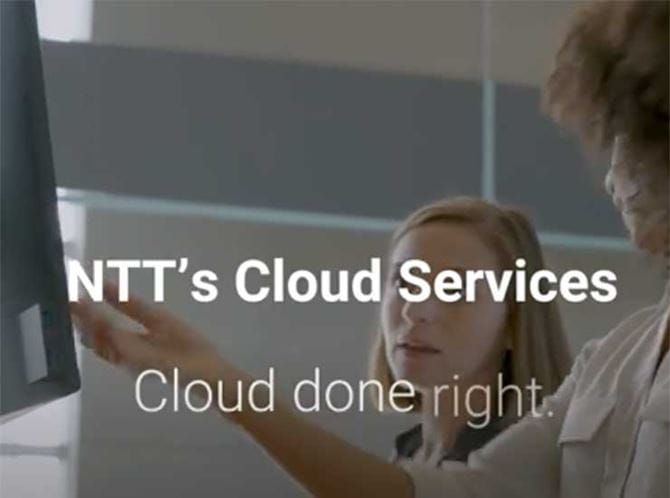-
Featured services
Harness innovation to deliver value
Ensure short-term stability as you design a roadmap for new use cases in your industry with emerging technologies.
Explore Connected Industries -
Services
View all services and productsLeverage our capabilities to accelerate your business transformation.
-
Services
Network as a Service
Popular Products
-
Private 5G
Our turnkey private 5G network enables custom-built solutions that are designed around unique use cases and strategies, and deployed, run and optimized through a full network-as-a-service model.
-
Managed Campus Networks
Our Managed Campus Networks services transform campus networks, corporate area networks and interconnected local area networks, and connect smart places and industries.
-
-
Services
Cloud Services
Popular Products
-
Cloud Migration and Transformation Services
Access the people, processes and technologies you need to deliver cloud migration projects that improve your return on investments.
-
Site Reliability Engineering Services
Get the most from your cloud investments when you harness our Site Reliability Engineering Services to support app development and lifecycle management.
-
-
Services
Edge as a Service
Client stories
-
Penske Entertainment and the NTT INDYCAR SERIES
Together with Penske Entertainment, we’re delivering digital innovations for their businesses – including INDYCAR, the sanctioning body of the NTT INDYCAR SERIES – and venues such as the iconic Indianapolis Motor Speedway, home to the Indianapolis 500.
-
Using private wireless networks to power IoT environments with Schneider Electric
Our combined capabilities enable a secure, end-to-end digital on-premises platform that supports different industries with the benefits of private 5G.
-
-
Services
Technology Solutions
Client stories
-
Services
Global Data Centers
-
Services
Digital Collaboration and CX

IDC MarketScape: Worldwide Datacenter Services 2023 Vendor Assessment
We provide a new kind of intelligent infrastructure to deliver better outcomes through technology.
Get the IDC MarketScape -
-
-
Insights
Recent Insights
-
The Future of Networking in 2025 and Beyond
-
Using the cloud to cut costs needs the right approach
When organizations focus on transformation, a move to the cloud can deliver cost savings – but they often need expert advice to help them along their journey
-
Make zero trust security work for your organization
Make zero trust security work for your organization across hybrid work environments.
-
-

Copilot for Microsoft 365
Everyone can work smarter with a powerful AI tool for everyday work.
Explore Copilot today -
-
Global Employee Experience Trends Report
Excel in EX with research based on interviews with over 1,400 decision-makers across the globe.
Get the EX report -
Discover how we accelerate your business transformation
-
About us
CLIENT STORIES
-
Liantis
Over time, Liantis – an established HR company in Belgium – had built up data islands and isolated solutions as part of their legacy system.
-
Randstad
We ensured that Randstad’s migration to Genesys Cloud CX had no impact on availability, ensuring an exceptional user experience for clients and talent.
-
-
CLIENT STORIES
-
Liantis
Over time, Liantis – an established HR company in Belgium – had built up data islands and isolated solutions as part of their legacy system.
-
Randstad
We ensured that Randstad’s migration to Genesys Cloud CX had no impact on availability, ensuring an exceptional user experience for clients and talent.
-
-
CLIENT STORIES
-
Liantis
Over time, Liantis – an established HR company in Belgium – had built up data islands and isolated solutions as part of their legacy system.
-
Randstad
We ensured that Randstad’s migration to Genesys Cloud CX had no impact on availability, ensuring an exceptional user experience for clients and talent.
-

NTT DATA and HEINEKEN
HEINEKEN revolutionizes employee experience and collaboration with a hybrid workplace model.
Read the HEINEKEN story -
- Careers
Topics in this article
Sometimes, the promise of cloud can seem to be a series of buzzwords strung together: agility, scalability, cost-efficiency, flexibility, reliability… But the real value of cloud depends on where your company is on the maturity journey.
If your business hasn’t really dwelled in the cloud and has an on-premises environment, you have to be prepared for the highest usage demands at any time, which means full infrastructure capacity at all times. By moving workloads, infrastructure and applications to the cloud, you pay only for the capacity you’re using and can increase it to cater for peaks in demand, such as Black Friday and Christmas for the retail industry.
But for organizations that are further along their cloud journey, cloud does so much more: it enables new business use cases, and business outcomes. In the automotive industry, for example, cloud is enabling use cases such as predictive fleet maintenance and software updates for driverless cars.
Close the gap between potential and profit
Cloud is meant to be cheaper than on-premises solutions. But sometimes an organization migrates their applications and infrastructure to the cloud only to end up paying more per month than before. The reason for this is poor planning, governance and optimization.
The key to successfully reaping the benefits of cloud is to plan ahead with a cloud strategy for the short, medium and long term instead of jumping in and then figuring things out. You have to take a step back and look at the end outcome.
First, determine what should move to the cloud and what should remain on-premises. I don’t think the paradigm of “cloud first and cloud only” is the trend. People have realized that it’s a hybrid world.
Work with a partner that can help you navigate governance and optimization for the things that are moving to the cloud. Together you can explore the solutions to questions such as:
- Do you have the right level of computing and storage?
- Are you optimizing month over month?
- Is there adequate governance for when developers spin up environments and shut them down? Are environments spun up when they don’t need to be?
Second, the business needs to find the right use cases. Before chasing cloud for business agility and other outcomes, you have to make sure that there’s a return on investment. This means defining your cloud economics, your cloud technology and the services you’re going to use, then implementing those use cases.
Cloud is complex, so keep it clean
Complexity doesn’t always start with the cloud but rather with on-premises infrastructure. As the environment evolves over time, IT might not even know what assets they have. In this sense, it’s like any storage space where you keep putting useful things. After a few years, you have no idea what’s in there.
So, to get cloud transformation right, you have to explore your IT assets and infrastructure and do a thorough spring clean. You need to know what you have before you can decide how to optimize your infrastructure and applications, and determine what should move to the cloud. This is where cloud advisory services and cloud strategy enter the picture.
Look at what data is related to recordkeeping and what is used for system innovation. Systems for keeping records are ideal for automation and industrialization, and yield a cost benefit. Client-facing systems hold better potential for innovation. These are the applications and infrastructure that you want to transform and modernize.
Security can never be an afterthought; it must be integrated into your design. The move to the cloud exposes you to the public domain. You have to protect not only customer information but also back-end systems. This also needs to be considered when deciding what stays on-premises and what needs to shift to the cloud. Some business-critical applications and algorithms have no business being near the public domain.
Don’t forget regulations and compliance. If you deal with any European data, their regulations on data protection are stringent. So, if you move to the cloud, your backup and disaster recovery systems have to be in the eurozone. If regulations are too restrictive, certain systems might not be a good candidate for the cloud. Industries like healthcare and pharmaceuticals have strict regulations, which creates more overhead in terms of compliance.
So, this is where you decide on your cloud model and secure it – public cloud, or a hybrid model with a private cloud and private data. If you move to the cloud, your architecture design, your setup, and your identity and access management and controls must take these security considerations into account, so that you have a safe and compliant environment.
- ALSO READ → What is multicloud as a service?
Topics in this article
Successful cloud transformation is usually a three-way play
The hyperscalers provide the cloud platform.
Your organization and IT team have their operating context needs, as well as IT and business pain points to address.
Then somebody has to come and stitch it all together and create the use cases on top of that – which is where service providers like NTT fit into the mix. We take these hyperscaler capabilities, work with businesses to discover their needs, then build the use cases on the top.
‘One and done’ does not optimize costs
Optimizing cost is a cyclical process. When you first move to the cloud, you need to look at many things: capacity planning, infrastructure planning, application planning and how the system is being used, then move on to benchmarking and mapping and optimizing the cloud infrastructure that will drive cost savings.
As part of our managed services, we regularly look at opportunities for optimization in terms of automation and infrastructure. Every month, we interact with our clients to find opportunities for year-on-year savings. This involves getting to know their patterns of use. Once we have identified a spending pattern and have an idea of the data volumes involved, we can work with you and the hyperscalers to create a better, cost-optimized IT estate.
Another component of cost optimization is industrialization. Are you writing automated Terraform scripts to spin up environments in real time, shutting them down and automating the whole process? This is a continual managed services journey.
Let your future ambitions determine your current cloud
When you first start your cloud journey, you need to consider not only your present state but also how your business will scale in future.
One of the biggest risks of cloud is vendor lock-in. If you architect your infrastructure based on only the current business state and do not model your cloud spend and return on investment on how it will progress, you won’t get the returns or outcomes you want.
Consider the true cost of owning and maintaining cloud – don’t just move to the cloud and hope that it’s cheaper.
Business use cases transcend buzzwords
When you look at cloud and modernization, some of the technology has almost become buzzwords – like AI, machine learning, IoT, edge and automation. But unless you have a business case that defines the architecture and the principle of using these services, you’re not going to really get the business outcome you want.
Cloud and technology help us realize use cases, but technology and the business use case have to go hand in hand. Think of modern ride-hailing services that use telecommunications, payment gateways and smartphones. The technology is driving the concept, but without the use case, the technology would be useless.
What to look for in a technology partner
One size does not fit all, so if somebody tries to sell you an out-of-the-box cloud product, that’s a red flag. For a system to work, you need customization. So, you want a partner who takes the time to sit down with you to understand the problem and craft a solution that addresses it. You want to work with a thought leader who can challenge the norms and do more than just keep the system running – that doesn’t translate to long-term cloud success.
The technology environment keeps changing with hardware, edge, hyperscalers, applications, infrastructure, and public and private cloud. Some partners offer a strong application and cloud presence; others offer a strong infrastructure presence. There are very few organizations in the world that have an end-to-end stack, from actually building a data center to working with partners to build private and public clouds.
A partner with an end-to-end stack can build end-to-end capability, and this is where NTT is uniquely positioned. We stretch from public cloud, edge as a service and deploying physical hardware and network services to cloud orchestration and physically constructing data centers, even for the hyperscalers.
This allows us to build end-to-end use cases for our clients and take them from cloud potential to cloud performance.
Read more about NTT’s Multicloud as a Service to unlock the value of multicloud solutions and gain greater cloud efficiencies with our end-to-end cloud lifecycle services.


